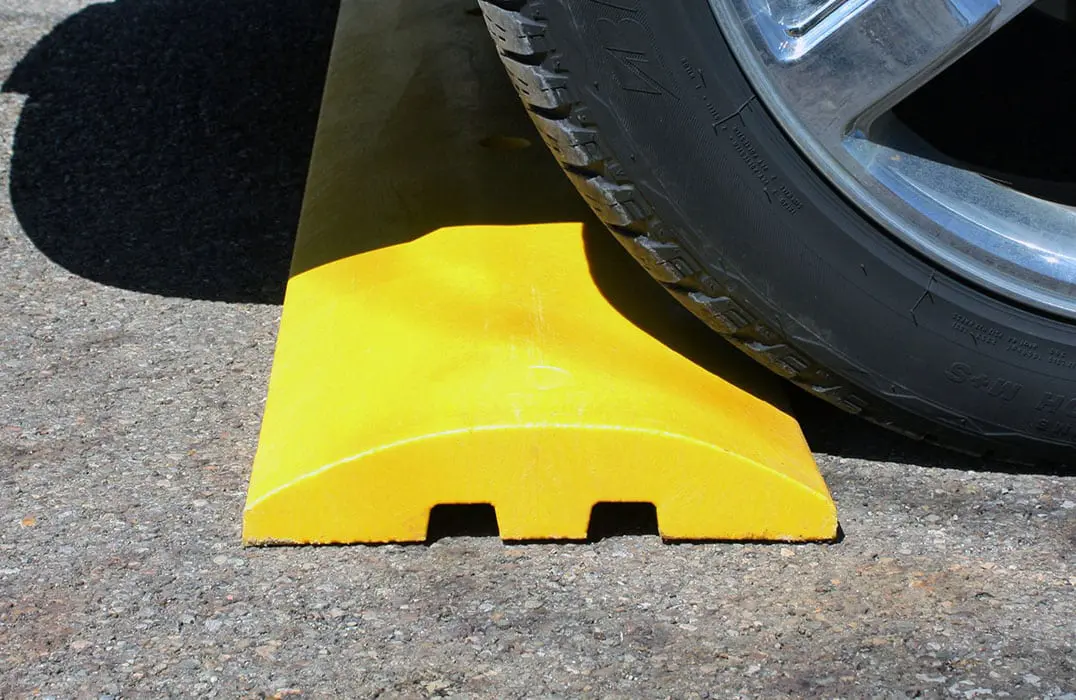Although you may have thought the difference between “speed bumps” and “speed humps” was mere terminology, the two are actually different traffic calming solutions with several distinguishing aspects of appearance, design, and application. Here is a guide to the major differences between these two speed reduction options.
Use
Speed bumps have long been widely used in side streets and parking lots to ensure that vehicles slow to a crawl. This reduces hazards for pedestrians by aiming to keep vehicle speeds down to about five miles per hour. The short travel distance to cross a speed bump ensures a sudden jolt to the vehicle as each axle passes over, encouraging drivers to slow down to avoid discomfort.
Speed humps, on the other hand, have a gentler slowing function. Traffic can continue to drive safely at fifteen to twenty-five miles per hour where speed humps exist. Because of this, speed humps are used on public roads, although mostly in residential areas where the posted speed limit itself is fairly low. Speed bumps are occasionally also used on these types of roads, but this can obstruct traffic flow, so they’re usually saved for private roads and parking lots.

The reason for these differences in use stems from differences in design. Speed bumps slow traffic more because their greater height (six inches) and width offers a much more sudden bump than that of a three- or four-inch high speed hump. In addition, the speed hump is usually long enough that the up-and-down changes in road height are felt one at a time rather than simultaneously. As a result, the speed hump provides two relatively gentle motions rather than the jolt a speed bump produces.
Our Recommendation
- Use Speed Humps for public roads to slow traffic to a safer speed
- Use Speed Bumps for private roads and parking lots to slow traffic to a crawl
Installation
The installation process is broadly similar for both speed bumps and speed humps, although there is a difference in installation time because a speed hump covers more road surface. However, there are different installation processes depending on what type of material is used. Rubber or plastic devices, which have more give and are less likely to damage vehicles, are installed by bolting a pre-formed piece to the road. Those made of traditional asphalt are installed by layering asphalt in the correct shape until the desired height is reached. Due to asphalt’s density when layered, there is little give, making it more effective at slowing traffic, though there is a slightly increased chance of damage to vehicles that pass over without slowing.
Our Recommendation
- Plan ahead for the installation time and type of material
- Choose the right style for your type of road
Weather
Weather variables can affect the application and performance of both speed humps and speed bumps. For example, both can be more difficult to see in the dark or in rainy or inclement weather. But their application in bad weather is another distinguishing factor, because they are not equal when there’s snow on the ground. Both are a nuisance to snowplows, but speed bumps are worse. Speed humps, because they’re lower to the ground and less invasive, are less of a hassle for snow plowing equipment. However, some plastic speed bumps are actually designed to be removed when cold weather sets in. These types of speed bumps may be an excellent choice for areas that are covered in snow for a large part of the year.
Our Recommendation
- Install Speed Humps if you use snowplows (or removable bumps)
As you can see, speed bumps and speed humps are designed for different situations and thus have different identifying and safety characteristics. By comparing these characteristics with the job at hand, you can tell which one will be the ideal traffic calming solution for your project.
Frequently Asked Questions
How effective are speed humps?
Speed humps are effective at reducing traffic speed flow to 10 to 30 miles per hour.
Do speed bumps have to be marked?
Speed bumps should be clearly marked to give time to slow their vehicle speed.
Do speed bumps damage cars?
Speed bumps can damage the underside of cars if they pass over the bump without slowing the speeding vehicle down.
Do you need planning permission for speed bumps?
Speed bumps are often bolted into the ground so permissions is usually required from the land owner or local governing body.
For more information, or for advice on choosing the best traffic calming option, contact Transline today.













